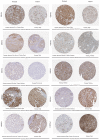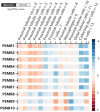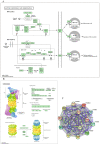Bioinformatic Analysis Identifying PSMB 1/2/3/4/6/8/9/10 as Prognostic Indicators in Clear Cell Renal Cell Carcinoma
- PMID: 35693739
- PMCID: PMC9149646
- DOI: 10.7150/ijms.71152
Bioinformatic Analysis Identifying PSMB 1/2/3/4/6/8/9/10 as Prognostic Indicators in Clear Cell Renal Cell Carcinoma
Abstract
Renal cancer incidence has been increasing across the world, clear cell renal cell carcinoma (ccRCC) represents the major subtype of renal cancer. The proteasome is involved in onset, metabolism and survival of tumor and has been recognized as a therapeutic target for various malignancies, while the role of β subunits of proteasome, PSMB gene family, in ccRCC has not been fully unveiled. Herein we investigated the expression and the prognostic role of PSMBs in ccRCC by analyzing a series of databases, including ONCOMINE, UALCAN, cBioPortal, STRING, GEPIA, GO and KEGG. Over-expressions of PSMB1/2/4/7/8/9/10 mRNA were found in ccRCC tissues compared to normal tissues, transcriptional levels of PSMB2/3/4/6/8/9/10 were significantly positively associated with patients' individual cancer stages and grades. Similar or higher levels of proteins encoded by PSMB1/2/3/7/8/9/10 were observed in tumor tissues compared to normal renal tissues. Further, high mRNA levels of PSMB1/2/3/4/6/10 were correlated with shorter overall survival in univariate analysis. Taken together, the results of our analysis implied that overexpression of PSMB1/2/3/4/6/8/9/10 were indicative of worse prognosis of ccRCC. However, further researches were required to validate our findings.
Keywords: PSMB; bioinformatic analysis; clear cell renal cell carcinoma; prognosis.
© The author(s).
Conflict of interest statement
Competing Interests: The authors have declared that no competing interest exists.
Figures








Similar articles
-
Abnormal expression and the significant prognostic value of aquaporins in clear cell renal cell carcinoma.PLoS One. 2022 Mar 4;17(3):e0264553. doi: 10.1371/journal.pone.0264553. eCollection 2022. PLoS One. 2022. PMID: 35245343 Free PMC article.
-
NCF1/2/4 Are Prognostic Biomarkers Related to the Immune Infiltration of Kidney Renal Clear Cell Carcinoma.Biomed Res Int. 2021 Oct 18;2021:5954036. doi: 10.1155/2021/5954036. eCollection 2021. Biomed Res Int. 2021. PMID: 34708124 Free PMC article.
-
Bioinformatics analysis of C3 and CXCR4 demonstrates their potential as prognostic biomarkers in clear cell renal cell carcinoma (ccRCC).BMC Cancer. 2021 Jul 15;21(1):814. doi: 10.1186/s12885-021-08525-w. BMC Cancer. 2021. PMID: 34266404 Free PMC article.
-
Identification of IL20RB as a Novel Prognostic and Therapeutic Biomarker in Clear Cell Renal Cell Carcinoma.Dis Markers. 2022 Mar 8;2022:9443407. doi: 10.1155/2022/9443407. eCollection 2022. Dis Markers. 2022. PMID: 35299868 Free PMC article.
-
High expression of P53-induced Ring-h2 protein is associated with poor prognosis in clear cell renal cell carcinoma.Eur J Surg Oncol. 2013 Jan;39(1):100-6. doi: 10.1016/j.ejso.2012.10.004. Epub 2012 Oct 24. Eur J Surg Oncol. 2013. PMID: 23102595
Cited by
-
Integrated Analysis of PSMB8 Expression and Its Potential Roles in Hepatocellular Carcinoma.Dig Dis Sci. 2025 Aug;70(8):2719-2738. doi: 10.1007/s10620-025-09040-9. Epub 2025 Apr 22. Dig Dis Sci. 2025. PMID: 40261568
-
Molecular markers of type II alveolar epithelial cells in acute lung injury by bioinformatics analysis.Sci Rep. 2023 Oct 18;13(1):17797. doi: 10.1038/s41598-023-45129-9. Sci Rep. 2023. PMID: 37853056 Free PMC article.
-
Immune regulation and prognostic prediction model establishment and validation of PSMB6 in lung adenocarcinoma.Front Genet. 2024 Oct 23;15:1458047. doi: 10.3389/fgene.2024.1458047. eCollection 2024. Front Genet. 2024. PMID: 39507618 Free PMC article.
-
Complexity in radiological morphology predicts worse prognosis and is associated with an increase in proteasome component levels in clear cell renal cell carcinoma.Front Oncol. 2022 Dec 8;12:1039383. doi: 10.3389/fonc.2022.1039383. eCollection 2022. Front Oncol. 2022. PMID: 36568232 Free PMC article.
-
PHD-BAH Domain in ASH1L Could Recognize H3K4 Methylation and Regulate the Malignant Behavior of Cholangiocarcinoma.Anticancer Agents Med Chem. 2024;24(17):1264-1274. doi: 10.2174/0118715206312004240712072532. Anticancer Agents Med Chem. 2024. PMID: 39034728
References
-
- Siegel RL, Miller KD, Jemal A. Cancer statistics, 2018. CA Cancer J Clin. 2018;68:7–30. - PubMed
-
- Linehan WM, Ricketts CJ. The Cancer Genome Atlas of renal cell carcinoma: findings and clinical implications. Nat Rev Urol. 2019;16:539–52. - PubMed
-
- Frank I, Blute ML, Cheville JC, Lohse CM, Weaver AL, Zincke H. An outcome prediction model for patients with clear cell renal cell carcinoma treated with radical nephrectomy based on tumor stage, size, grade and necrosis: the SSIGN score. The Journal of urology. 2002;168:2395–400. - PubMed
-
- Patard JJ, Kim HL, Lam JS, Dorey FJ, Pantuck AJ, Zisman A. et al. Use of the University of California Los Angeles integrated staging system to predict survival in renal cell carcinoma: an international multicenter study. Journal of clinical oncology: official journal of the American Society of Clinical Oncology. 2004;22:3316–22. - PubMed
MeSH terms
Substances
LinkOut - more resources
Full Text Sources
Medical
Miscellaneous

